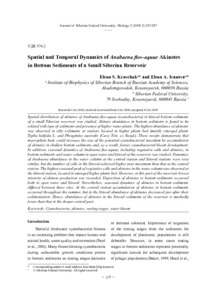Spatial and Temporal Dynamics of Anabaena flos-aquae Akinetes in Bottom Sediments of a Small Siberian Reservoir
Скачать файл:
URI (для ссылок/цитирований):
https://elib.sfu-kras.ru/handle/2311/1464Автор:
Kravchuk, Elena S.
Ivanova, Elena A.
Дата:
2009-06Аннотация:
Spatial distribution of akinetes of Anabaena flos-aquae (cyanobacteria) in littoral bottom sediments
of a small Siberian reservoir was studied. Akinete abundance in bottom sediments is found to be
related with type of sediments and presence of higher water plants. The highest abundance of akinetes
was observed in silty sediments at stations located in higher plants bed (mainly emerged plants
Typha latifolia L. and Phragmites australis (Cav.) Trin. ex Steud.). These results demonstrate that
macrophyte beds could increase the size of the potential cyanobacterial inoculum by accumulation
of akinetes in shallow bottom sediments and, as a result, favour cyanobacterial bloom development.
In addition, seasonal dynamics of Anabaena flos-aquae, including vegetative cells and akinetes, in
bottom sediments and water column in open water and littoral of the reservoir was studied. Dynamics
of Anabaena abundance in the water column at the central station and littoral stations were very
similar, but the number of cells in the littoral achieved higher year maximum than that at the central
station. The highest seasonal peak of vegetative cells and akinetes in the water column was observed at
the littoral station, located in emerged higher plants bed. However, at this part of the reservoir lowest
intensity of akinete production was recorded. Deposition of akinetes to bottom sediments occurred
both in open water and littoral. Nevertheless, seasonal dynamics of akinetes in bottom sediments
differed between these sites. At the central station accumulation of akinetes in bottom sediments
occurred throughout the summer, but in the littoral abundance of akinetes decreased just after their
sedimentation. Hence, abundance of akinetes in the littoral sediments of the reservoir is markedly
lower than that in the deeper central part.

